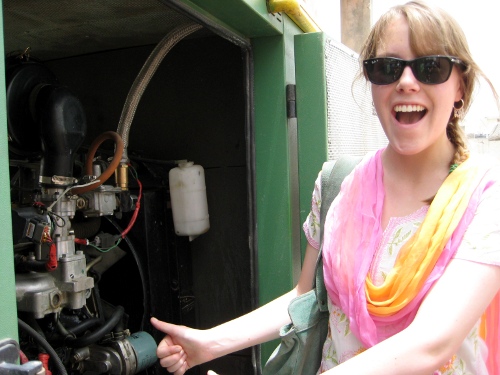
Namaskar! I’m writing this sitting in my apartment in New Delhi, India, almost 10,000 miles (nearly half the circumference of the planet!) away from my hometown of Lower Lake, Calif.
I’m here, working for Tata Teleservices Limited (TTSL) under the Tata International Social Entrepreneurship Scheme, an internship designed to connect college students from partner universities (such as UC Berkeley, where I’m about to enter my junior year) and various Tata group companies all over India.
Tata is a large, multinational conglomerate, with interests in many products that Americans use every day, such as Tetley Tea and Land Rover/Jaguar, and many other goods and services worldwide.
In India, you will see Tata everywhere, from automobiles to satellite television, to food and hotels; the prestigious Taj line of hotels is also a Tata group company.
I was assigned to Tata Teleservices Limited (TTSL), Tata group’s presence in the Indian telecom sector.
Like any other corporate entity, TTSL has environmental issues. Most people (including me) don’t associate cell phones with generating much pollution, but the Indian telecom sector is the second-largest consumer of diesel in the country, just under Indian railroads.
Why so much juice? Well, cell phone towers run on electricity, and with frequent power cuts and unavailable electricity access (especially in rural areas) diesel generators are used to provide back up and full time power.
Providing 400 million subscribers with mobile service requires over 250,000 towers, each using five to 10 liters of diesel per day ... one can imagine the release of carbon!
To offset this massive amount of pollution, TTSL is looking into all sorts of green technology, from solar and wind power to biomass generators.
It was my responsibility as an intern to assess TTSL’s current green initiatives, and to provide recommendations for improvement and new areas of research and investment.
When I first received this assignment, I was surprised and apprehensive. On my application, I had mentioned an interest in the environment and some past volunteer involvement with two local conservation groups, the Lake County Land Trust and the Redbud Audubon Society.
However, at UC Berkeley, I’m a full blown liberal arts and humanities student, majoring in linguistics and Indian languages. How was I qualified to fill the role of a green technology consultant?
My first visit out in the field, on June 22, tested these qualifications.
A group from the Delhi TTSL office including me ventured out to North Delhi to visit some of TTSL’s new “green” cell tower sites. The sites on the tour included a compressed natural gas generator in Model Town, and a fuel cell in Nangloi.
Braving the heat with limited air conditioning, we shuttled from one location to the next, quickly viewing the sleek, shining equipment.
Returning to the office later that afternoon, I proudly showed the rest of the Corporate Sustainability Team some of the photos I’d taken.
“See this?” I asked, smugly gesticulating towards my camera’s display screen. “It’s a fuel cell.”
“Are you sure?” one of my neighbors asked. “This looks an awful lot like a tank of hydrogen to me.”
A Google search revealed what a fuel cell truly looks like. Staring at the image – a small, elegant and expensive-looking machine that resembled a battery – I realized exactly how underqualified I was.
I was nervous before I started this internship, but this gaff made me painfully aware of how green I was in my knowledge of environmentally-friendly technology.
In the following weeks, however, I have managed to learn enough about cutting-edge green technology to offer TTSL some recommendations, and to daydream about environmentally friendly changes I’d like to support both at UC Berkeley and in Lake County.
We have so many resources at our disposal, I’ve realized how easy it is for us to reduce our carbon footprint, and how shameful it is that we haven’t already.
Apart from these green initiatives, I’ve also learned a lot about corporate sustainability – TTSL’s way of doing corporate social responsibility – and how companies can provide ethical, sustainable vocational and economically empowering opportunities for the less fortunate of its community; methods from which both US companies and communities could benefit.
I take off in two weeks, and I leave behind a bustling, frenetic city that I now love. Delhi – and India as a whole – for me is an amazing, inspiring place, and I find it familiar, comfortable and ordinary.
I always think of Rudyard Kipling’s “The Ballad of East and West”:
East is East and West is West and never the twain shall meet,
No one ever remembers the rest of the poem:
But there is neither East nor West, Border, nor Breed, nor Birth,
When two strong men stand face to face,
tho’ they come from the ends of the earth!
India is similar to Lake County in some fundamental ways. The same problems and concerns exist in both places: the same anxiety for the impoverished, the same crusade for public awareness; the same struggle between empathy and apathy. Ten thousand miles away, and we can still learn a lot from one another.
Observing the corporate sustainability work TTSL is engaged in has shown me how I can apply the same mentality and strategy to projects and programs back home, helping to make American corporate sustainability as real as i have seen it to be in India.
Kate Lyons is a 2008 Lower Lake High School graduate, born in St. Helena and raised in Lower Lake, Calif. She currently is a junior at University of California, Berkeley, majoring in linguistics with a minor in global poverty and practice.
Follow Lake County News on Twitter at http://twitter.com/LakeCoNews and on Facebook at http://www.facebook.com/pages/Lake-County-News/143156775604?ref=mf .